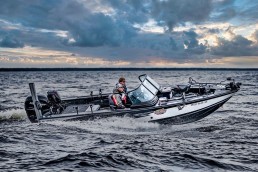Handling a Boat in Rough Water
SHARE THIS POST
Ted Takasaki shares some boat handling tips to keep you safe on rough waters.
Over the past 30-plus years, I have participated in close to 200 professional fishing tournaments and spent over 3,000 days on the water, in various boats, on all types of waters! This includes rivers, natural lakes, reservoirs and the Great Lakes. High winds, heavy current, rough water, big storms, tornadoes, waterspouts, hail, fog, sub-freezing temperatures—you name it, I’ve probably driven a boat in all different conditions.
With this first-hand experience, I can safely say I am an expert on the topic of freshwater boats, handling a boat in all sorts of conditions, and boat selection.
I will tell you right off the bat, do not go onto big waters and big waves being overconfident! Maintain healthy respect for Mother Nature and physics. You may only have one chance at getting back to the dock in one piece.
Given all that, a boat is still a fantastic vehicle for enjoyment, fishing, family, fun and getting from one side of the lake to the other. Always keep your phone handy and check the weather conditions every few hours. The phone apps we have today are incredible at predicting weather, wind and rough water.
Now, to start with, do you already own a boat? What is your primary use of your boat—fishing, water skiing, or pleasure cruising around the lake? What kind of lake do you like to boat or fish? What kind of fish do you like to fish for?
Are you enjoying this post?
You can be among the first to get the latest info on where to go, what to use and how to use it!
Let’s start with the lakes/rivers you like to boat on. The bigger the boat, the bigger the water you can go to. If the winds are calm and you have a 16-foot boat, then you can go out on small ponds, but don’t go out on a gigantic lake like Lake Erie. If the winds come up from the wrong direction, things can get bad fast. I’ve been on the Great Lakes when it was dead calm going out, but turned into a raging tempest within just a few minutes. The bottom line is to use a boat that is suitable for the lake you are planning on going to. Build up your experience little by little.
Always carry life saving devices on your boat, such as life vests for everyone, a compass or good electronics with mapping capability, a sound signaling device like a whistle or horn, visual signaling devices such as flares or bright flags, communication equipment like a cell phone or radio, and a throwable flotation cushion.
There is absolutely no fish worth losing a life for, so have healthy respect for the water and weather. But if you do get caught in rough waves, here are a few tips to get you back to shore.
- Try to get to the closest shore. Either go directly with the wind/waves, or tack 45 degrees to the waves. Avoid going directly into the waves if you can.
- Trim your engine and adjust your speed to keep the bow up above the waves. Ride them up and then coast down the back side.
- Look for islands or peninsulas which block the wind and waves. If it is too rough, anchor and stay put on the calm side until the storm blows over.
- If all else fails, then change your plan by heading to the closest launch ramp. If need be, catch a ride on land back to your truck and trailer.
Just don’t be a hero. Stay safe by keeping an eye out on the weather and know your limitations. The fish will still be there the next time you go out!
Get more helpful boating tips and insight from the pros who know in every issue of MidWest Outdoors, available by subscribing on our website.
MWO
SHARE THIS POST
You may also like...
Nothing found.
Did you enjoy this post?
You can be among the first to get the latest info on where to go, what to use and how to use it!
Ted Takasaki
Ted Takasaki is an International Fishing Hall of Fame professional angler who has been featured in many national outdoor magazines and television shows. Takasaki has appeared in front of thousands of angling enthusiasts and is considered one of America’s top walleye and multispecies anglers. Follow him on his Facebook page.
